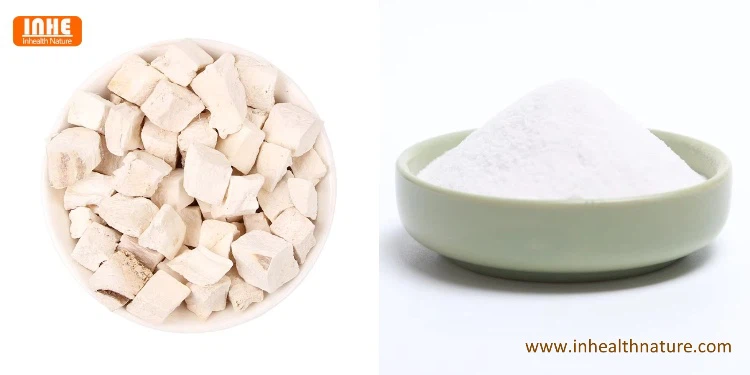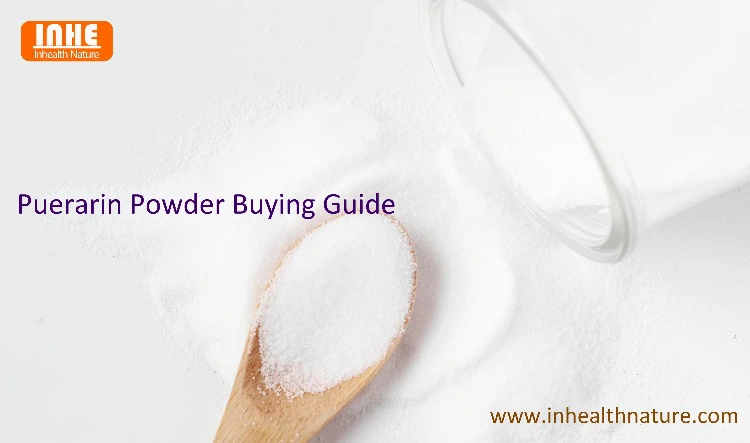Puerarin Powder Buying Guide
Jun 17, 2025
Perhaps you may have some difficulties in choosing Puerarin Powder, as I did before. After so many years of industry experience, we have summarized the common doubts and solutions as follows, hoping to help you:
what are the extraction processes of puerarin root extract?
Puerarin root powder, a major bioactive isoflavone found in Pueraria lobata (kudzu root), is extracted using different methods, each with distinct advantages. Below are two key extraction processes:
Solvent Extraction with Resin Adsorption & Elution
A. Process Steps
a. Pretreatment & Extraction: Dried kudzu root is crushed and decocted with water for two times.
b. Resin Adsorption (Purification): Macroporous adsorption resins (the ion exchange macroporous resin can be D-392 or D-290 resin, preferably D-392 resin), because the resin can well adsorb and retain puerarin and related structural analogs. The concentrated extract is passed through the resin column, where puerarin is adsorbed while impurities are washed away.
c. Elution: During elution, firstly elute with 2-4 column volumes, preferably 3 column volumes of water, then elute with 4-6 column volumes, preferably 5 column volumes of 60% ethanol, and collect ethanol to obtain the concentrated puerarin extract.
d. Crystallization & Drying: The concentrate is cooled to induce crystallization, then dried (spray drying or vacuum drying) to obtain puerarin root powder.
B. Advantages
a. High purity (>98%) is achievable with resin purification.
b. Cost-effective for large-scale production.
c. Environmentally safer than pure organic solvents.
Supercritical CO2 Extraction (SFE-CO2)
A. Process Steps
a. Preparation: Kudzu root extract is loaded into the extraction vessel.
b. Extraction: CO2 is pressurized (20-40 MPa) and heated (30-60℃) to a supercritical state. A co-solvent (e.g., ethanol, 5-15%) is often added to enhance puerarin solubility.
c. Separation: The CO2-puerarin mixture passes into a separator where pressure is reduced, causing CO2 to gasify and puerarin to precipitate.
d. Collection & Purification: The crude extract may undergo further purification (e.g., recrystallization) to improve purity.
B. Advantages
a. No toxic solvent residues; ideal for high-purity applications (e.g., pharmaceuticals).
b. Lower thermal degradation risk compared to solvent extraction.
c. Environmentally friendly (CO2 is recyclable).

what are the relevant international regulations?
Here are the key international regulations governing puerarin root powder, based on its use in pharmaceuticals, dietary supplements, and cosmetics, as derived from the search results:
Pharmaceutical-Grade Regulations
Purity Standards:
a. Must meet ≥98% purity (HPLC) for pharmaceutical applications, as per USP/EP/BP pharmacopeias.
b. Heavy metals (Pb, As, Hg, Cd) must comply with limits.
c. Clinical Use: Approved in China for cardiovascular diseases (e.g., angina, myocardial infarction) but requires prescription due to potential liver toxicity risks.
Dietary Supplement Regulations
Labeling & Safety:
a. In the U.S. and EU, puerarin is classified as a dietary ingredient under DSHEA and EFSA guidelines, but must include disclaimers (e.g., "Not evaluated by FDA").
b. Prohibited claims to treat diseases unless backed by clinical trials.
c. Dosage Limits: No established daily value, but studies suggest 50–200 mg/day for cardiovascular support.
Import/Export Controls
a. Documentation: Requires Certificates of Analysis (COA), SDS, and third-party testing (e.g., SGS) for cross-border trade.
b. Banned Markets: Restricted in some countries (e.g., Canada) due to phytoestrogen content unless approved as a natural health product.
Key Compliance Tips
a. Verify supplier certifications (ISO, GMP, SGS).
b. Monitor updates from regulatory bodies (FDA, EMA, NMPA) for evolving restrictions.
what is the optimal dosage for different health benefits?
The optimal dosage of puerarin root powder varies depending on the targeted health benefit, route of administration, and individual factors such as bioavailability and metabolism. Below is a summary of evidence-based dosages for different health applications, derived from scientific studies and clinical trials:
Cardiovascular Health & Metabolic Syndrome
a. Oral dosage: 100-200 mg in animal studies showed antihypertensive, anti-ischemic, and lipid-lowering effects by upregulating hepatic ACE2 and improving glucose uptake in insulin-resistant adipocytes.
b. Human equivalent dose: Clinical trials suggest 200-400 mg/day of standardized extract (containing 10-15% puerarin) improves lipid profiles and arterial stiffness.
Bone Health & Osteoporosis
a. In vitro/animal data: 2-10 mg orally enhanced osteoblast proliferation and reduced bone resorption markers (CTX-I).
b. Clinical trials: 200-400 mg/day of puerarin root extract (37.5 mg puerarin/capsule) significantly reduced bone turnover markers in postmenopausal women.
Diabetes & Glucose Metabolism
a. Animal models: 50-100 mg improved insulin sensitivity via PI3K/Akt and AMPK pathways.
b. Human studies: Limited, but 200-300 mg/day (split doses) showed glycemic control benefits in preliminary trials.
Anti-Inflammatory & Antioxidant Effects
a. Dosage range: 200-400 mg in diets reduced oxidative stress markers (MDA, SOD) and inflammation (TNF-α, IL-6) in metabolic syndrome models.
b. Aquaculture studies: 200-400 mg feed enhanced immune function in fish, suggesting potential for human applications at lower doses.
Safety & Compliance Considerations
a. Toxicity: No significant adverse effects at therapeutic doses, but high doses (>1,000 mg) may cause mild hepatotoxicity.
b. Bioavailability: Poor oral absorption; formulations like nanoparticles or phospholipid complexes are recommended for higher efficacy.
c. Regulatory status: Classified as a dietary supplement in the EU and US; standardized extracts should meet USP/EP guidelines for isoflavone content.
Key Recommendations
a. General health: 50–200 mg/day (standardized to ≥10% puerarin).
b. Therapeutic use: 200–400 mg/day, divided into 2–3 doses to mitigate low bioavailability.
c. Formulation: Combine with piperine or lipids to enhance absorption.

is puerarin root extract glutan-free and vegan?
Yes. Puerarin root powder is gluten-free and vegan. It does not contain common allergens such as peanuts, tree nuts, soy, dairy, eggs, fish, or shellfish. It is free from parabens, phthalates, and residual solvents. It is suitable for individuals with dietary restrictions or ethical preferences. Always verify product certifications from the supplier before purchasing to ensure compliance with specific dietary needs.
how to use puerarin root extract?
How to Take Puerarin Powder
A. Oral Consumption (Most Common Method)
a. With Water/Juice: Mix 50–200 mg (or as directed) in a glass of water, juice, or tea. Stir well before drinking (puerarin is not highly soluble in water).
b. With Food: Taking it with a fat-containing meal (e.g., nuts, avocado, olive oil) may improve absorption since puerarin is fat-soluble. Avoid taking high-fiber meals, as fiber may reduce absorption.
B. Enhanced Absorption Methods
a. Combined with Piperine (Black Pepper Extract): Studies suggest that piperine (5-10 mg) can enhance puerarin absorption by inhibiting liver metabolism.
b. Liposomal or Phospholipid Complex Formulations: Some supplements combine puerarin with lecithin or liposomes to improve bioavailability.
C. Sublingual Use (Less Common, but Faster Absorption)
a. A small amount (e.g., 20–50 mg) can be held under the tongue for 1–2 minutes before swallowing.
b. This may allow some direct absorption into the bloodstream, bypassing the digestive system.
Timing of Consumption
A. Best Taken
a. With meals (especially those containing healthy fats) for better absorption.
b. Twice daily (morning and evening) if using higher doses (e.g., 200–400 mg/day).
B. Avoid Taking
a. With high-calcium foods (e.g., dairy), as calcium may interfere with absorption.
b. Right before intense exercise, as it may affect blood pressure regulation.
Safety & Precautions
a. Possible Side Effects: Rare, but high doses (>1,000 mg/day) may cause mild digestive discomfort or dizziness.
b. Drug Interactions: It may interact with blood pressure medications (due to vasodilatory effects). It may affect blood sugar levels, so diabetics should monitor glucose levels closely.
c. Pregnancy/Breastfeeding: Not enough safety data; avoid unless under medical supervision.
are there any fillers or additives in puerarin root extract?
Puerarin root powder is typically available in two forms: raw extracts (containing a percentage of puerarin alongside other natural compounds from kudzu root) and high-purity isolates (standardized to ≥98% puerarin). Here's what the available data indicates about fillers and additives:
Fillers in Commercial Puerarin Root Powder
a. No fillers in pure puerarin powder: High-quality puerarin powder (e.g., 99% purity) is usually free from fillers, binders, or artificial additives, as confirmed by suppliers offering GMP-certified and ISO-compliant products.
b. Exceptions: Some lower-grade extracts (e.g., 40% isoflavone blends) may contain carriers like maltodextrin or rice flour for stability, but reputable suppliers disclose this in product specifications.
Common Additives (If Present)
a. Anti-caking agents: Minimal silicon dioxide (<1%) may be added to prevent clumping in powder form.
b. Flow aids: Magnesium stearate is occasionally used in capsule formulations but is rare in pure powder.
c. Excipients in enhanced formulations: Some products combine puerarin with piperine (black pepper extract) or phospholipids to improve absorption, but these are functional additives, not fillers.
How to Verify Purity
a. Check Certificates of Analysis (COA): Reputable suppliers provide COAs detailing puerarin content (e.g., HPLC-tested ≥98%) and confirm the absence of undeclared additives.
b. Third-party testing: Products with SGS, USP, or Eurofins certifications are less likely to contain hidden additives.
Whether you're a nutraceutical brand, contract manufacturer, or health product formulator, sourcing bulk Puerarin Powder from a reliable partner ensures quality and compliance. Contact us at april@inhealthnature.com for factory price, technical data, and logistics support worldwide.






